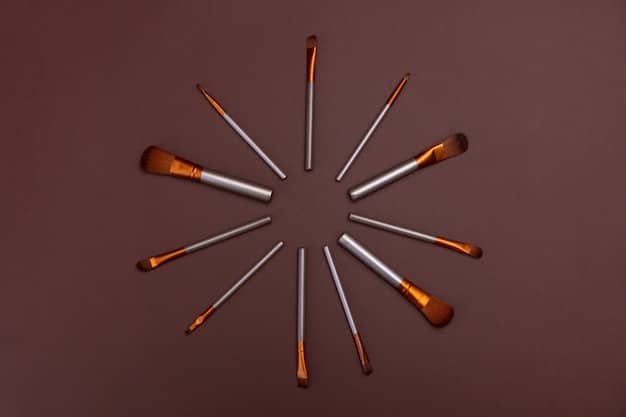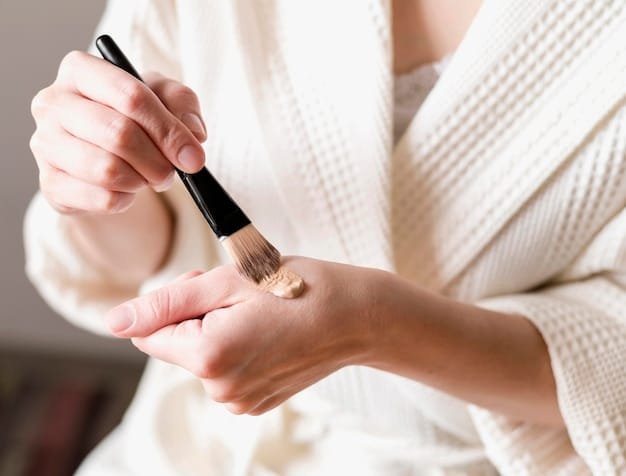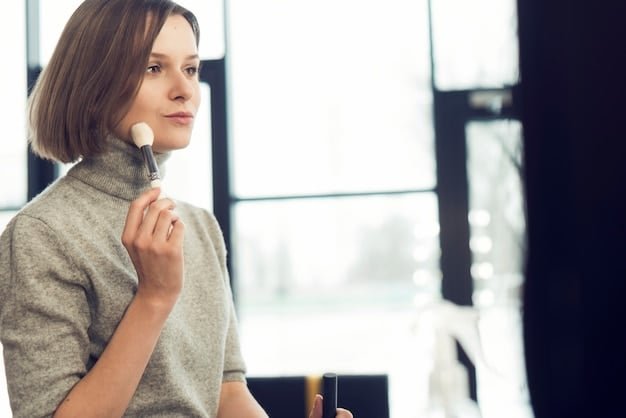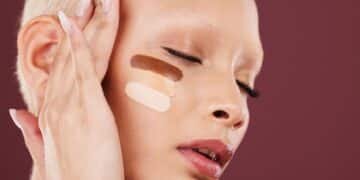The Best Face Makeup Brushes for Beginners: US Guide

The best face makeup brushes for beginners in the US involve selecting essential tools like a foundation brush, concealer brush, powder brush, blush brush, and contour brush, focusing on quality and versatility to create a flawless base.
Embarking on your makeup journey can be exciting, but choosing the right tools is crucial for achieving that flawless look. This guide simplifies your introduction to the best face makeup brushes for beginners: a comprehensive guide to building your kit in the US, ensuring a smooth and enjoyable application process.
Essential Face Makeup Brushes for Beginners
Starting your makeup collection can feel overwhelming with the sheer number of brushes available. However, focusing on a few essential brushes will set you up for success. Understanding the purpose of each brush will make your makeup application smoother and more effective.
Foundation Brush
A foundation brush is a staple for creating a smooth base. There are two main types: flat foundation brushes and buffing brushes.
Concealer Brush
A concealer brush is designed to precisely apply concealer to blemishes, dark circles, and other imperfections.

- Flat Foundation Brush: Ideal for liquid or cream foundations, providing full coverage.
- Buffing Brush: Perfect for blending foundation seamlessly, creating a natural finish.
- Stippling Brush: Offers light to medium coverage, great for a natural, airbrushed look.
Choosing the right foundation brush depends on your desired coverage and foundation type. Experiment to find what works best for you.
Selecting the Right Powder Brush
A powder brush is essential for setting your makeup and reducing shine. The ideal brush is large, fluffy, and soft, allowing for even application of powder without disrupting the makeup underneath.
Types of Powder Brushes
There are several types of powder brushes, each suited for different purposes.
Application Techniques
How you use your powder brush can significantly impact the final result.

- Large, Fluffy Brush: Best for applying loose powder all over the face.
- Tapered Brush: Great for precise application in areas like the T-zone.
- Kabuki Brush: Provides heavier coverage, ideal for setting makeup thoroughly.
Use a light hand and apply powder in a rolling motion to avoid cakiness. Focus on areas that tend to get oily, such as the forehead, nose, and chin.
Blush and Contour Brushes: Adding Dimension
Blush and contour brushes are key for adding color and definition to your face. The right brushes will help you achieve a natural, sculpted look.
A blush brush should be soft and angled, allowing for precise application of color to the cheeks. A contour brush should be dense and angled, perfect for creating shadows and defining your features.
- Angled Blush Brush: Fits the contours of the cheeks perfectly for easy application.
- Tapered Contour Brush: Allows for precise sculpting and definition.
- Fan Brush: Great for applying highlighter lightly and precisely.
When applying blush, smile to find the apples of your cheeks and blend the color upwards towards your temples. For contour, apply the product under your cheekbones, along your jawline, and on the sides of your nose to create dimension.
Brush Materials: Synthetic vs. Natural
Makeup brushes are typically made with either synthetic or natural bristles, each offering distinct advantages. Understanding the differences will help you choose the best options for your needs.
Synthetic Bristles
Synthetic brushes are made from man-made materials such as nylon or taklon.
Natural Bristles
Natural brushes are made from animal hair, such as goat, squirrel, or pony.
Synthetic brushes are cruelty-free, easy to clean, and work well with cream and liquid products. Natural brushes are excellent for blending powder products and tend to be softer. If you have sensitive skin or allergies, synthetic brushes are often the best choice.
Caring for Your Makeup Brushes
Properly caring for your makeup brushes is essential for maintaining their quality and hygiene. Regular cleaning prevents bacteria buildup and ensures smooth makeup application.
Clean your brushes at least once a week with a gentle brush cleanser or mild soap. Rinse thoroughly and allow them to air dry horizontally to prevent water from seeping into the handle.
- Daily Cleaning: Use a brush cleanser spray to remove excess product after each use.
- Weekly Cleaning: Wash your brushes with a gentle cleanser and warm water.
- Proper Drying: Lay brushes flat on a towel to dry completely.
Taking care of your brushes will extend their lifespan and keep your skin healthy. Dirty brushes can harbor bacteria, leading to breakouts and skin irritation.
Building Your Beginner Brush Kit on a Budget
You don’t need to spend a fortune to build a quality makeup brush kit. There are many affordable options available that offer excellent performance.
Affordable Brush Sets
Consider purchasing a brush set to get a range of essential brushes at a lower cost.
Individual Budget-Friendly Brushes
Look for individual brushes from drugstore brands that are known for their quality.
Many affordable brands offer great brushes that perform just as well as their high-end counterparts. Read reviews and compare prices to find the best deals. Start with the essential brushes and gradually add more as needed.
| Key Point | Brief Description |
|---|---|
| ✅ Foundation Brush | Creates a smooth and even base for makeup. |
| ✨ Powder Brush | Sets makeup and reduces shine for a flawless finish. |
| 🎨 Blush Brush | Adds color and dimension to the cheeks. |
| 🖌️ Concealer Brush | Precisely applies concealer to imperfections. |
Frequently Asked Questions (FAQs)
▼
For beginners, essential brushes include a foundation brush, concealer brush, powder brush, blush brush, and an eyeshadow blending brush. These brushes cover the basics of creating a full face of makeup.
▼
Ideally, makeup brushes should be cleaned at least once a week. Brushes used for liquid or cream products should be cleaned more frequently to prevent bacteria buildup.
▼
Synthetic brushes are great for cream and liquid products, while natural brushes excel with powders. The best choice depends on your personal preference and the types of products you use most often.
▼
Lay your brushes flat on a clean towel to air dry. Avoid drying them upright, as water can seep into the handle and loosen the glue, causing the bristles to fall out.
▼
Yes, baby shampoo is a gentle and effective option for cleaning makeup brushes. It’s mild enough to not damage the bristles and effectively removes makeup residue and bacteria.
Conclusion
Building your first makeup brush kit doesn’t have to be daunting. By focusing on essential brushes and understanding their uses, you can create a versatile and effective set that helps you achieve any makeup look. Remember to care for your brushes properly to maintain their quality and hygiene, ensuring a flawless finish every time.





